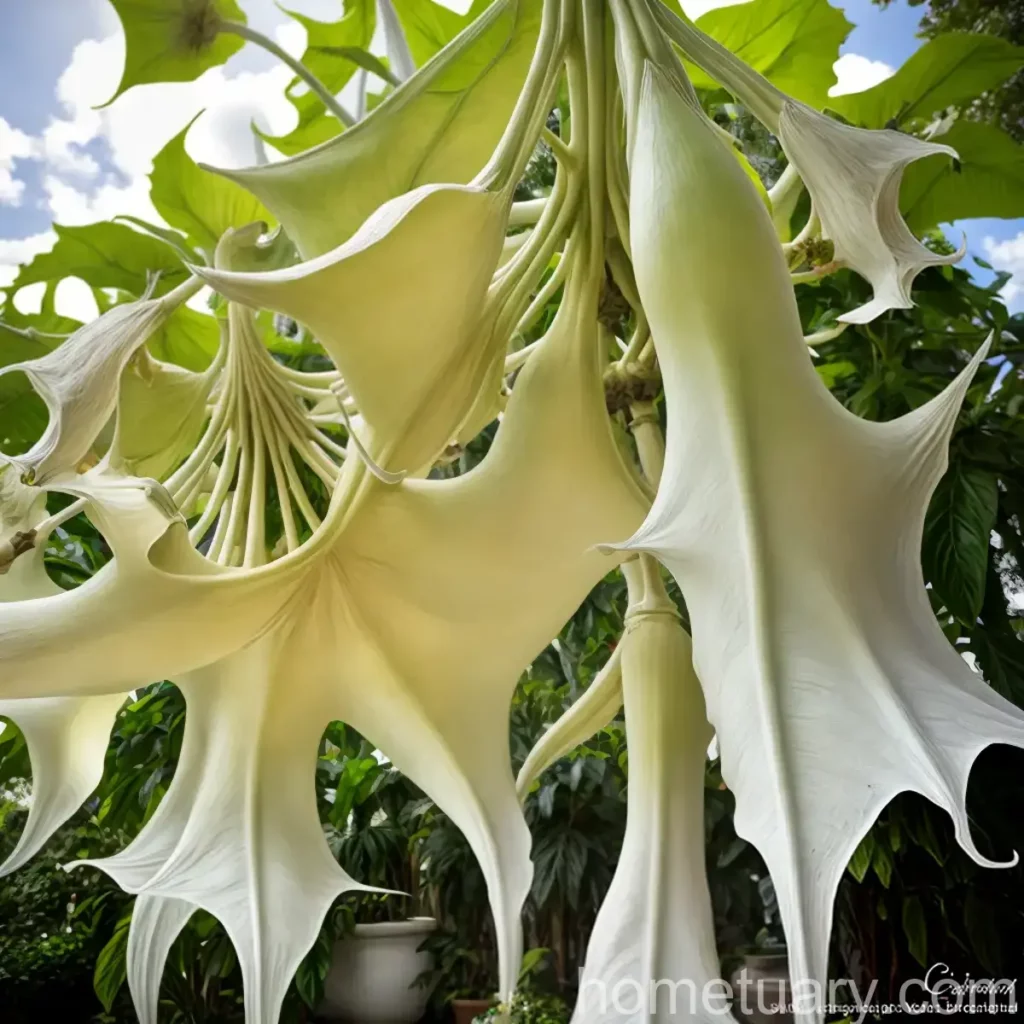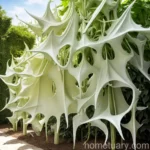Angel’s Trumpet (Brugmansia x candida): A Complete Guide to Care and Cultivation
Introduction
Plants have always been an integral part of human life, offering beauty, sustenance, and even medicinal properties. Among the diverse array of plants, the angel’s trumpet (Brugmansia x candida) stands out for its stunning flowers, alluring fragrance, and interesting cultural significance. In this comprehensive guide, we will delve into all aspects of angel’s trumpet care, including its culture, uses, water, sunlight, fertilizer, soil, pruning, propagation, container preferences, diseases, pests, and much more. Whether you are an experienced horticulturist or a novice plant enthusiast, this article will provide you with invaluable insights into the care and cultivation of this captivating plant.
What is Angel’s Trumpet (Brugmansia x candida)?
Angel’s trumpet, scientifically known as Brugmansia x candida, is a genus of flowering plants that belong to the Solanaceae family, which also includes other well-known plants such as tomatoes, potatoes, and peppers. Originating from South America, particularly the Andes region, angel’s trumpet is renowned for its large, trumpet-shaped flowers that hang elegantly from the plant. These flowers are often white, but can also appear in shades of yellow, peach, or even pink, adding a burst of color and charm to any garden or landscape.
This plant is a small tree or shrub with large, alternate leaves and woody stems. Its impressive, pendulous flowers and intoxicating fragrance make it a popular choice for ornamental gardens and landscaping projects around the world. However, it is important to note that despite its breathtaking beauty, angel’s trumpet contains toxic compounds, particularly in its leaves, flowers, and seeds. Therefore, caution must be exercised when handling this plant, especially around pets and children.
Key Takeaways – Angel’s Trumpet (Brugmansia x candida)
Before diving into the specifics of angel’s trumpet care, let’s touch upon some key takeaways to remember:
- Scientific Name: Brugmansia x candida
- Family: Solanaceae
- Origin: South America
- Characteristics: Large, pendulous trumpet-shaped flowers in white, yellow, peach, or pink hues; woody stems and large, alternate leaves.
- Caution: All parts of the plant, especially the leaves, flowers, and seeds, contain toxic compounds and should not be ingested.
With these essential points in mind, we can explore the intricacies of caring for angel’s trumpet, including its cultural requirements, uses, and maintenance needs.
Culture
Cultural practices are fundamental to the successful growth and development of any plant species. Understanding the cultural requirements of angel’s trumpet is crucial for creating an environment in which it can thrive. Let’s explore the various cultural aspects of growing and nurturing this stunning plant.
Water
Proper watering is critical for the health and vitality of angel’s trumpet. As a tropical plant, it thrives in moist, well-draining soil. During the growing season, which typically spans spring to fall, it is essential to keep the soil consistently moist but not waterlogged. However, during the winter months or when the plant is not actively growing, it is important to reduce the frequency of watering to prevent root rot.
Watering Requirements:
– Frequency: Water the plant regularly, aiming for moist soil without waterlogging.
– Seasonal Variation: Reduce watering in the winter or during periods of dormancy.
Sunlight
Like many tropical plants, angel’s trumpet craves abundant sunlight to flourish. It thrives in full sun to partial shade, although it tends to produce more flowers in full sun. When grown indoors, it is crucial to position the plant in a spot that receives bright, indirect sunlight to promote healthy growth and blooming.
Sunlight Needs:
– Outdoor: Full sun to partial shade.
– Indoor: Bright, indirect light.
Fertilizer
Providing adequate nutrients is essential for angel’s trumpet to produce vigorous growth and bountiful blossoms. A balanced, water-soluble fertilizer formulated for flowering plants can be applied regularly during the growing season to support the plant’s nutritional needs. However, it is important to taper off fertilizer applications in the fall to prepare the plant for dormancy.
Fertilization Tips:
– Type: Use a balanced, water-soluble fertilizer for flowering plants.
– Application: Apply fertilizer regularly during the growing season, and reduce frequency in the fall.
Soil
Angel’s trumpet thrives in rich, well-draining soil that retains moisture without becoming waterlogged. A combination of organic matter, such as compost or well-rotted manure, along with loamy soil provides an ideal growing medium for this plant. Additionally, maintaining a slightly acidic to neutral soil pH (6.0-7.5) is recommended for optimal growth.
Recommended Soil Type:
– Composition: Rich, well-draining soil with organic matter.
– pH Range: Slightly acidic to neutral (6.0-7.5).
Pruning
Pruning is an important aspect of angel’s trumpet care, serving both aesthetic and maintenance purposes. Regular pruning helps to shape the plant, remove dead or damaged growth, and promote air circulation within the canopy. It is important to note that all parts of the plant, including the sap, contain toxic compounds, so caution should be exercised when handling and pruning.
Pruning Techniques:
– Timing: Prune after the blooming period to shape the plant and remove dead or damaged growth.
– Caution: Wear gloves and exercise caution when pruning due to the plant’s toxic nature.
Propagation
Angel’s trumpet can be propagated through several methods, including stem cuttings, layering, and even seeds. For most home gardeners, propagating through stem cuttings is the preferred and most effective method. Propagation is typically done in spring or summer when the plant is actively growing.
Propagation Methods:
– Stem Cuttings: Collect stem cuttings and root them in a well-draining rooting medium.
– Timing: Propagate during the active growing season for best results.
Container Popularity
Angel’s trumpet is a popular choice for container gardening, thanks to its stunning appearance and fragrant blossoms. Growing it in a container allows for greater control over its environmental conditions and makes it easier to overwinter in colder climates. Additionally, it serves as a striking centerpiece for patios, porches, and outdoor living spaces.
Container Gardening Tips:
– Container Size: Use a large, sturdy container to accommodate the plant’s root system.
– Mobility: Position the container in a location that receives ample sunlight and can be easily moved indoors during the winter.
Common Diseases
Just like any other plant, angel’s trumpet is susceptible to certain diseases that can impact its overall health and vigor. It is important for plant enthusiasts and gardeners to be aware of these potential threats and take proactive measures to prevent and manage them effectively.
Some of the common diseases that can affect angel’s trumpet include:
- Leaf Spot: Characterized by the appearance of small, dark spots on the leaves, often caused by fungal pathogens.
- Powdery Mildew: A fungal disease that manifests as a powdery, white growth on the leaves and stems.
- Root Rot: Caused by overwatering or poorly draining soil, leading to the decay of the plant’s root system.
- Botrytis Blight: A fungal infection that causes brown lesions on flowers, often accelerated by high humidity and poor air circulation.
Proper cultural practices, including adequate spacing of plants, providing good air circulation, and avoiding overhead watering, can help prevent the onset and spread of these diseases. Additionally, applying fungicidal treatments at the first sign of an outbreak can help mitigate the spread of fungal diseases.
Disease Diagnosis
Diagnosing diseases in angel’s trumpet often involves careful observation of the plant’s symptoms and, in some cases, microscopic examination to identify the presence of specific pathogens. Here are some key signs and symptoms to watch for when diagnosing common diseases in angel’s trumpet:
- Leaf Spot: Look for small, dark spots or lesions on the leaves, with possible yellowing or browning of affected foliage.
- Powdery Mildew: Notice the presence of a powdery, white coating on the leaves and stems, often accompanied by leaf distortion.
- Root Rot: Check for wilting, yellowing, or browning of the leaves, as well as mushy, waterlogged roots.
- Botrytis Blight: Examine flowers for brown lesions and a fuzzy, gray mold that develops under humid conditions.
Upon observing any of these symptoms, it is essential to take prompt action to address the underlying causes and administer appropriate treatments to prevent further damage to the plant.
Common Pests
In addition to diseases, angel’s trumpet is also susceptible to infestations by various pests that can compromise its health and visual appeal. Some of the common pests that may affect this plant include:
- Aphids: Small, sap-sucking insects that cluster on tender new growth, causing stunted growth and distorted leaves.
- Spider Mites: Tiny pests that feed on the undersides of leaves, leading to stippling, discoloration, and webbing.
- Whiteflies: Small, white insects that congregate on the undersides of leaves and excrete sticky honeydew, promoting the growth of sooty mold.
- Caterpillars: Larval stages of various insect species that chew on leaves, causing ragged edges and defoliation.
Implementing integrated pest management (IPM) strategies, such as regular monitoring, physical removal of pests, and the use of insecticidal soaps or horticultural oils, can help manage and control pest infestations without resorting to harsh chemical treatments.
Botanist’s Tips
As a plant scientist with a passion for horticulture, I’m excited to share some expert tips and insights for caring for angel’s trumpet based on years of experience and research. These recommendations can help enthusiasts achieve success in cultivating and nurturing these captivating plants.
Fun Facts
- Angel’s trumpet flowers are known for their intoxicating fragrance, which becomes especially potent at night, attracting pollinators such as moths.
- The South American indigenous tribes have historically used various parts of the angel’s trumpet plant in traditional rituals and ceremonies due to its hallucinogenic properties, although this is highly dangerous and not recommended.
- In some cultures, the blooming of angel’s trumpet flowers is associated with mysticism and spirituality, often symbolizing divine communication or otherworldly experiences.
Links to External Resources
- The American Brugmansia and Datura Society (ABADS): A leading organization dedicated to the appreciation, cultivation, and conservation of angel’s trumpet and related plants.
- Royal Horticultural Society (RHS) – Brugmansia: An extensive resource offering insights into the cultivation and care of Brugmansia in garden settings.
Conclusion
Angel’s trumpet (Brugmansia x candida) undoubtedly captivates enthusiasts with its breathtaking flowers, alluring fragrance, and rich cultural history. By understanding and implementing the recommended cultural practices, disease management strategies, and expert tips, gardeners and plant lovers can ensure the health and vitality of their angel’s trumpet plants, while also enjoying the stunning visual display they offer. With proper care, this exotic plant can thrive, gracing gardens and outdoor spaces with its enchanting blooms and serving as a testament to the beauty and diversity of the plant kingdom.
Whether it is the delicate scent of its blossoms or the striking appearance of its trumpet-shaped flowers, angel’s trumpet remains an awe-inspiring addition to any horticultural collection. By embracing the principles of responsible care and cultivating a deeper understanding of this remarkable plant, we can truly appreciate the marvels of nature that it embodies.
References
- National Gardening Association. (2021). Plant Care Guides: Brugmansia. https://garden.org/plants/group/brugmansias/
- University of Florida IFAS Extension. (n.d.). Brugmansia spp. and Datura spp. https://gardeningsolutions.ifas.ufl.edu/plants/ornamentals/brugmansias-and-daturas.html















